East of the Central Court of Knossos Palace, there is, quite logically, the East Wing and it consists of several sections. Some of them have been reconstructed over time, while many more are still in the shape of ruins. By the way, let me say that a partial problem here lies in the fact that the information boards that are distributed more or less throughout the entire site and that show both the drawn contours of different buildings and their distribution appear too confusing and they are not appropriate at all for laymen visitors. The expert visitors probably do not even need these boards, but they are made, as is often the case, by experts who do not know how to adapt their expert knowledge to laymen. I think this is a pity because it prevents non-experts from learning something new.
Be as it may, I started my visit of the East Wing precisely from the Central Court for there is a canopied Grand Staircase here.
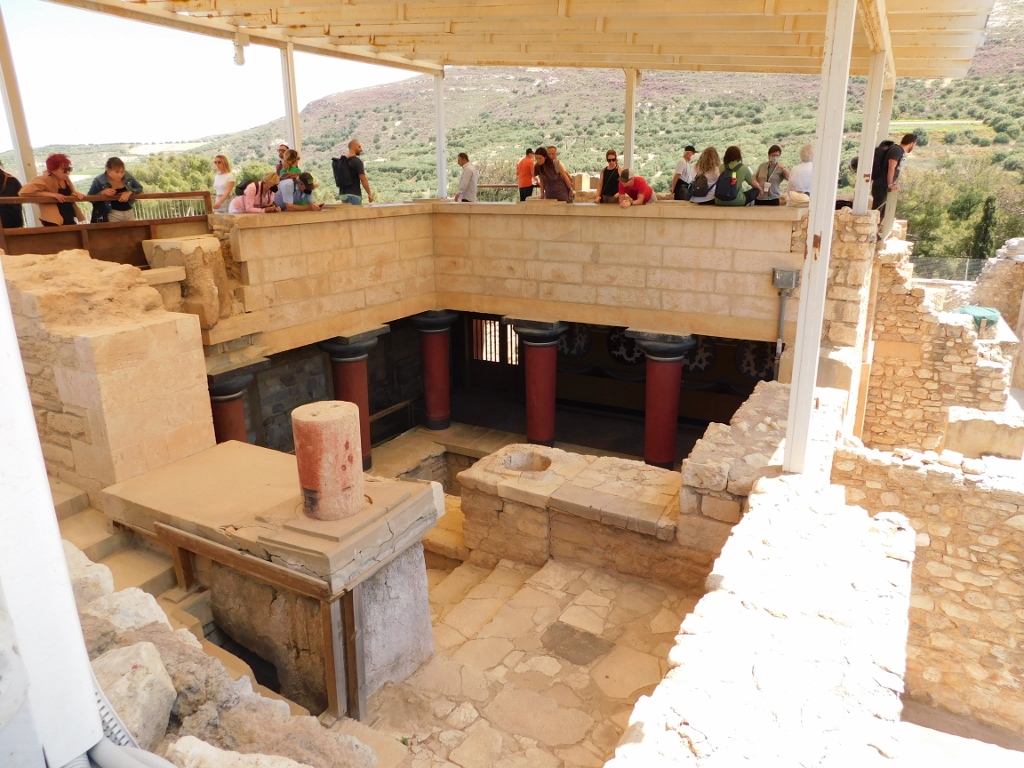 Grand Staircase
Grand Staircase
This is one of the most interesting structures at the site, primarily because two floors below the level of the Central Court have been preserved. It is not permitted to go down here, but this can all be looked at quite nicely from the top as can be seen from the photo above.
The staircase was found right in its original place and when the visitor leans over a little it is possible to see that the lowest floor is being worked on, while the first floor below the level of the Central Court has been quite nicely restored.
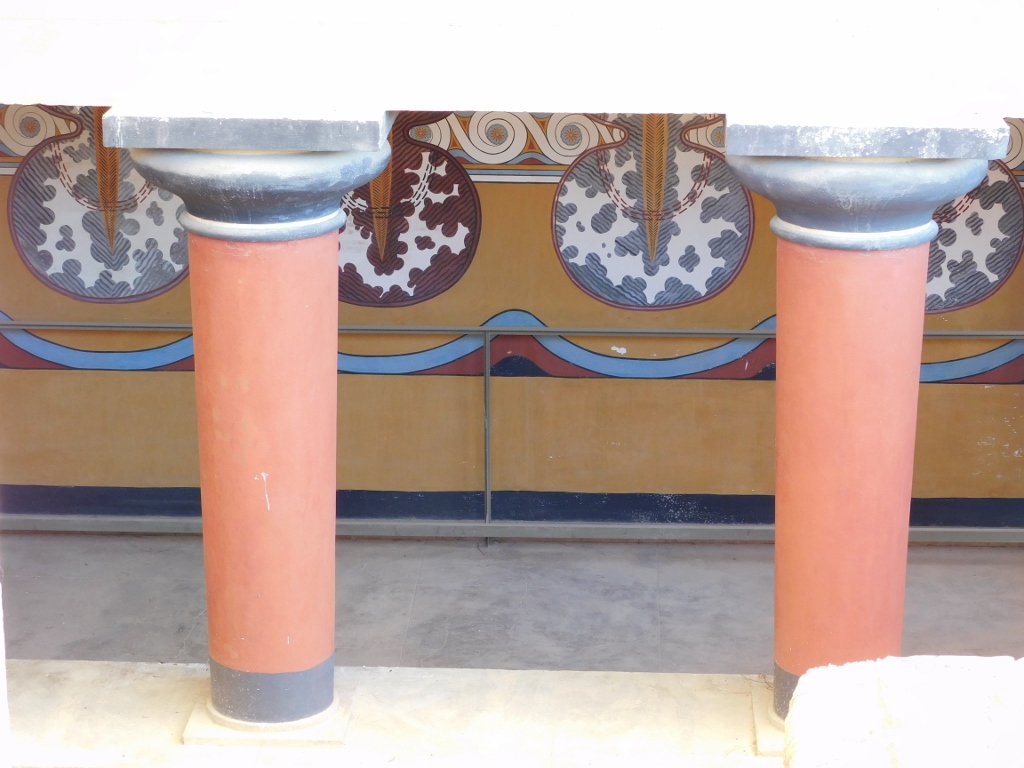 Grand Staircase, a detail
Grand Staircase, a detail
Thus, it is possible to see nice columns, as well as frescoes on the walls that depict Figure-of-Eight Shields.
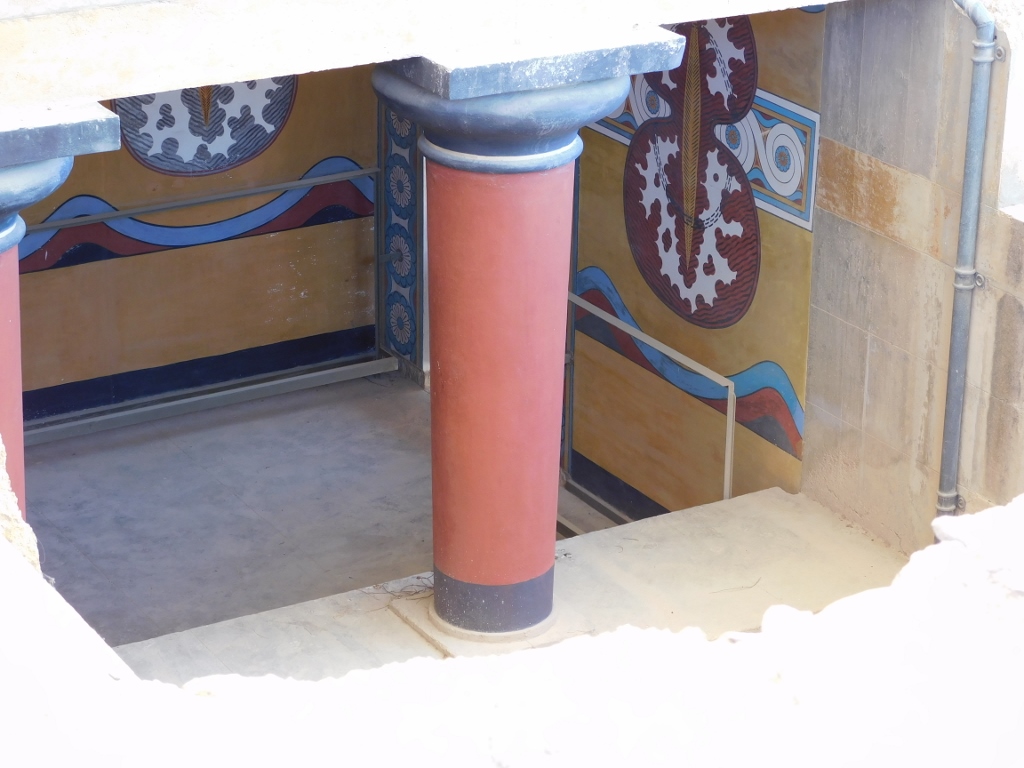 Grand Staircase, a detail
Grand Staircase, a detail
This motif that can be seen on the wall of the hall that goes around the Grand Staircase is typical of Mycenae and precisely this shows that Mycenae and Mycenaean culture had a strong impact on Crete and the Minoan culture. Moreover, the inhabitants of Crete always had contacts and exchanges both with continental Greece and Egypt, but it was the Mycenaeans who conquered the palaces of the Minoans around 1420-1375 BCE. This coincides with the terminal phase of the Minoan civilisation and at that time Knossos played more an administrative role. Also in this period, some inscriptions appeared that were written in the Linear B script used by the Mycenaeans. In other words, the direct “heirs” of the Minoan culture were the conquerors from Mycenae.
Now I only walked leisurely around the central lightwell looking at the details, as much as this was possible from the top. Arthur Evans believed that the Palace was the seat of the kings of Knossos and he also expanded this to the position that the East Wing contained the residential sections intended for the royal family.
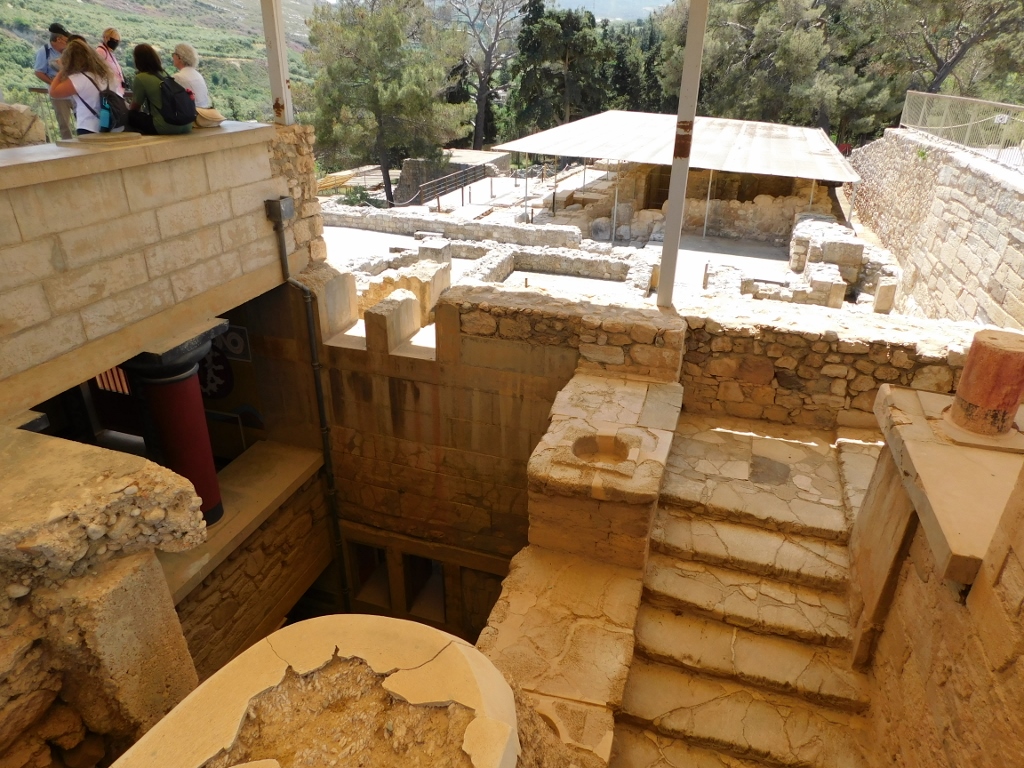 Grand Staircase, a detail
Grand Staircase, a detail
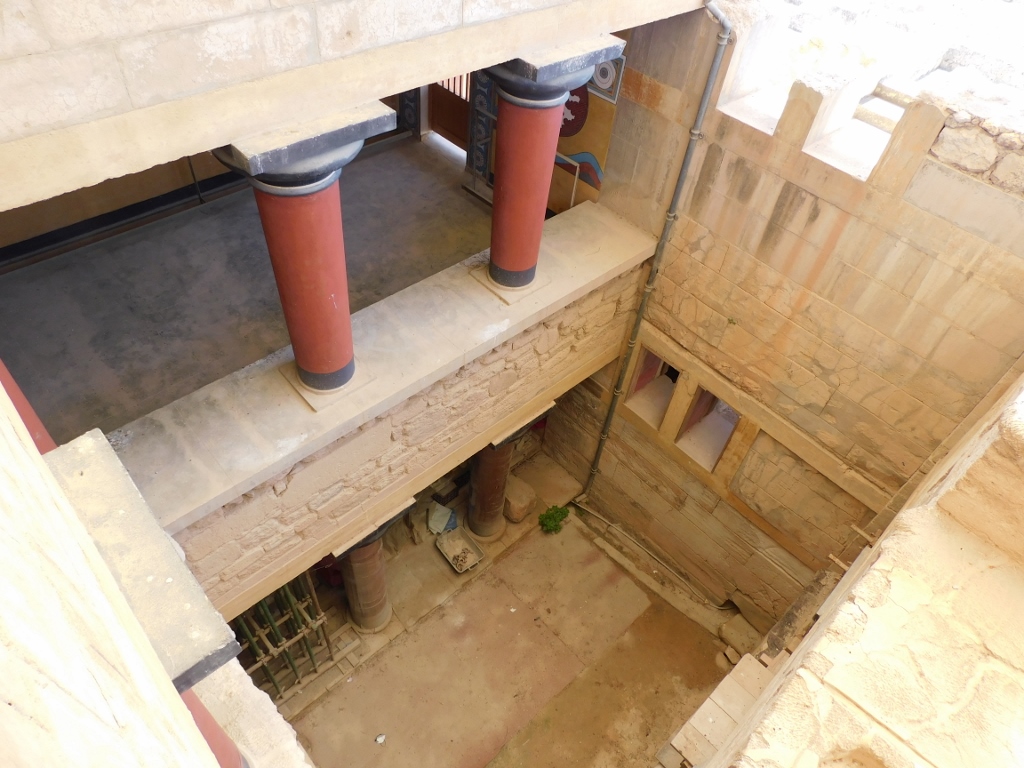 Grand Staircase, a detail
Grand Staircase, a detail
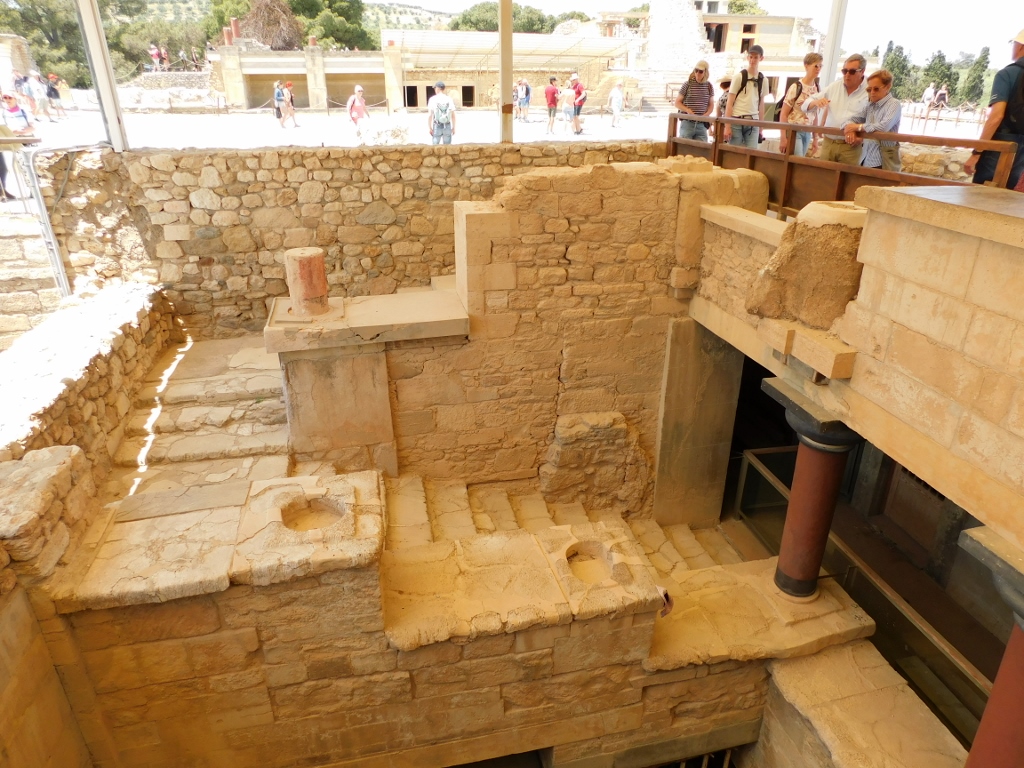 Grand Staircase, a detail
Grand Staircase, a detail
I have already said that the East Wing encompasses a large number of structures and some of them are both very important and would be interesting for me to see, such as the Hall of Double Axes. According to what I have read, this is where engraved images of double axes were found on the walls. I have already mentioned earlier that this symbol and its archaic name, labrys, constitute the basis for the theory that the word “labyrinth” that originates right from this place means in fact “[the palace of] the double axe” and not entangled hallways and rooms from which one cannot get out. Although, it must be said, there is no lack of such entangled distribution of rooms at Knossos Palace.
For a reason unknown to me, the access of visitors to the broader area of the site was prevented in several places by ropes. That’s why I could only take photos from the platform that practically exists above the hall surrounding the Grand Staircase of some parts of the site that I could otherwise not visit.
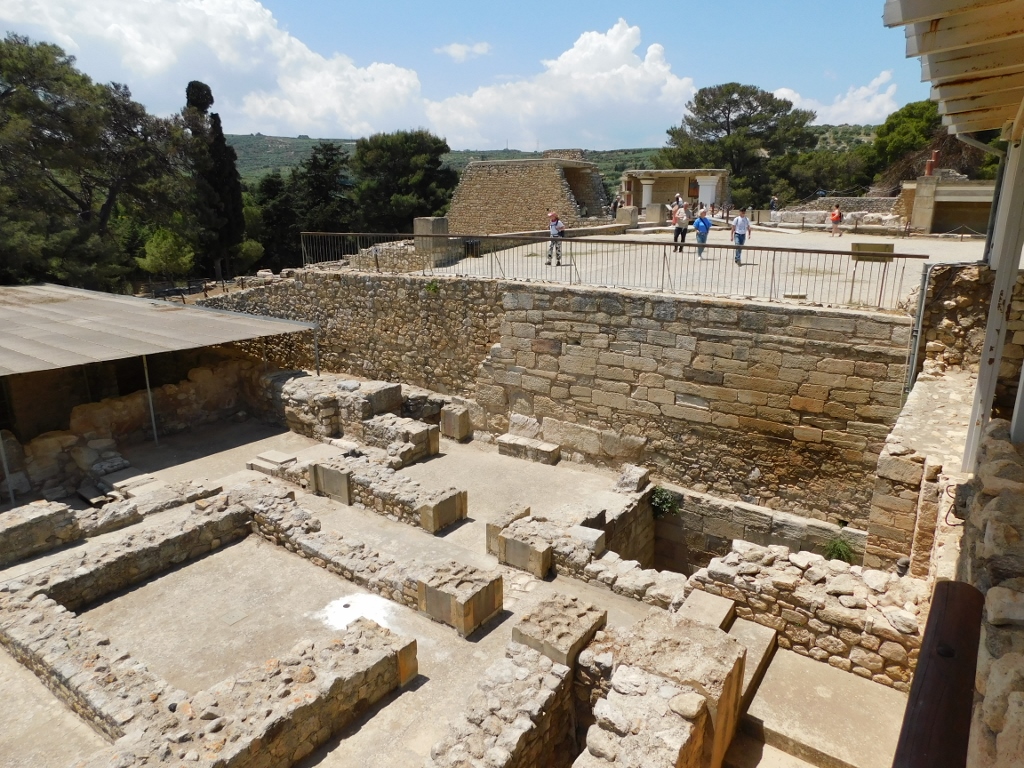 Knossos Palace, southwest of the Grand Staircase
Knossos Palace, southwest of the Grand Staircase
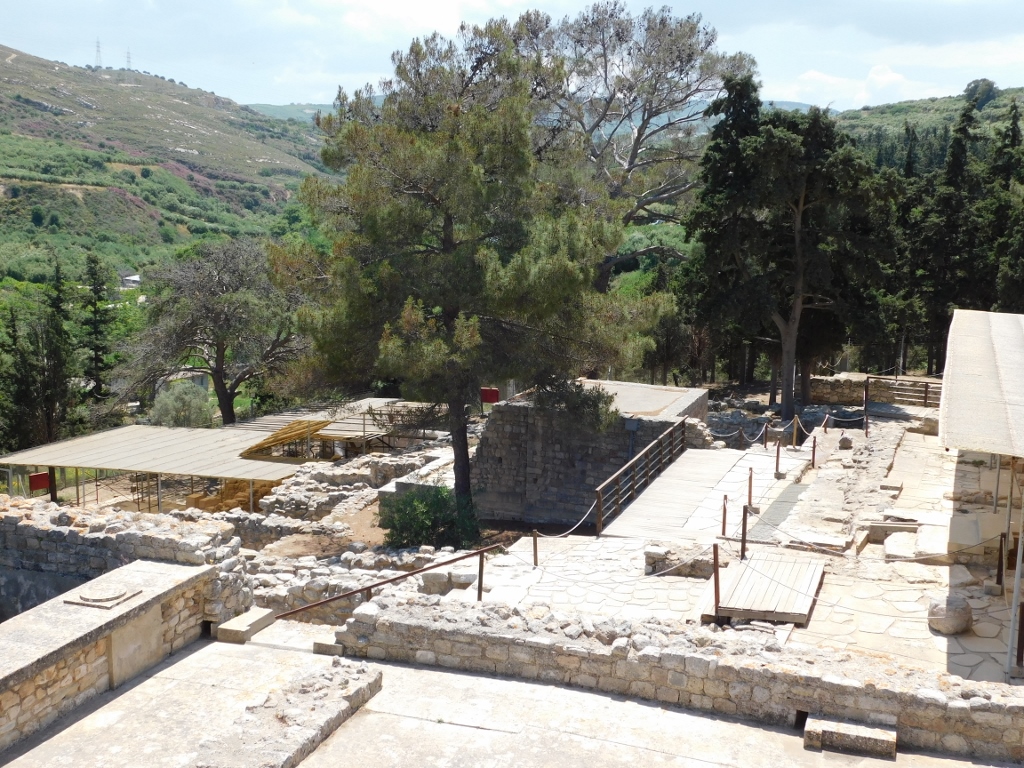 Knossos Palace, southeast of the Grand Staircase
Knossos Palace, southeast of the Grand Staircase
In addition, a large part of the East Wing cannot be seen from the level of the Central Court also because that section of the palace is practically distributed along the slope. By the way, the “roof” of the Hall of Double Axes can be seen in the following photo at the bottom and in the middle/right.
 Knossos Palace, east view from the Grand Staircase
Knossos Palace, east view from the Grand Staircase
So, I visited only what I could, such as the Magazine of the Medallion Pithoi. This storage building got its name after the large vessels for the keeping of food that are decorated with relief medallions and stylised ropes, while being dated back to the New Palace Period (1700-1450 BCE).
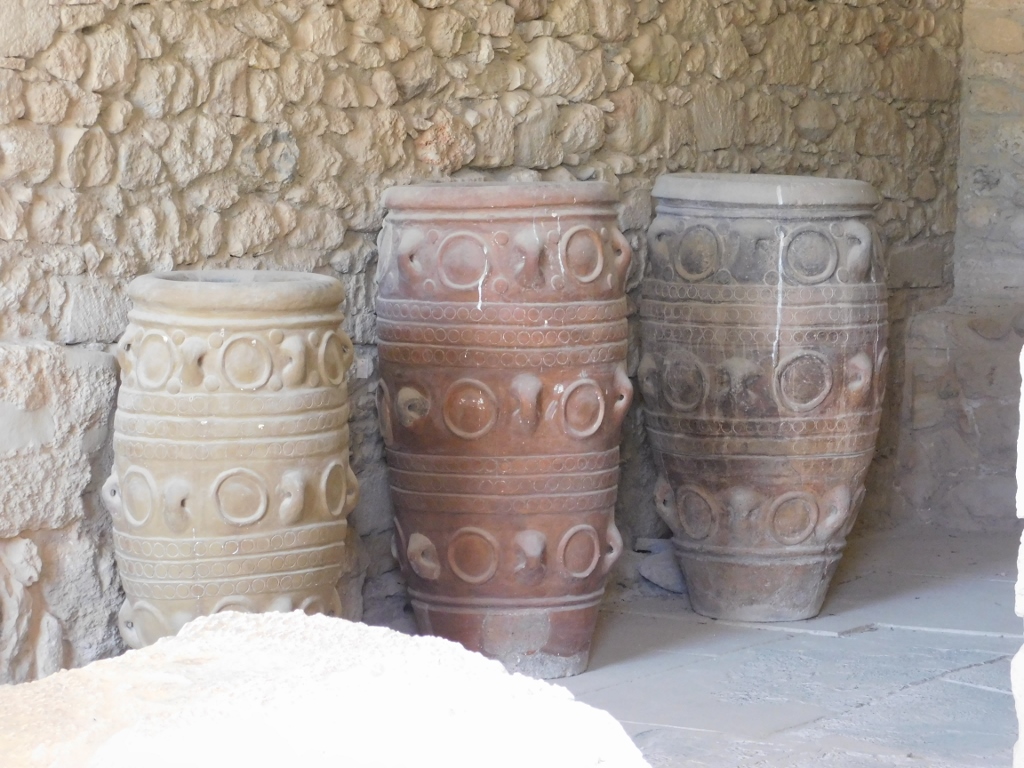 Medallion pithoi
Medallion pithoi
I walked a little more around the East Wing, i.e., around its remains and then I concentrated more on the picturesque West Bastion.
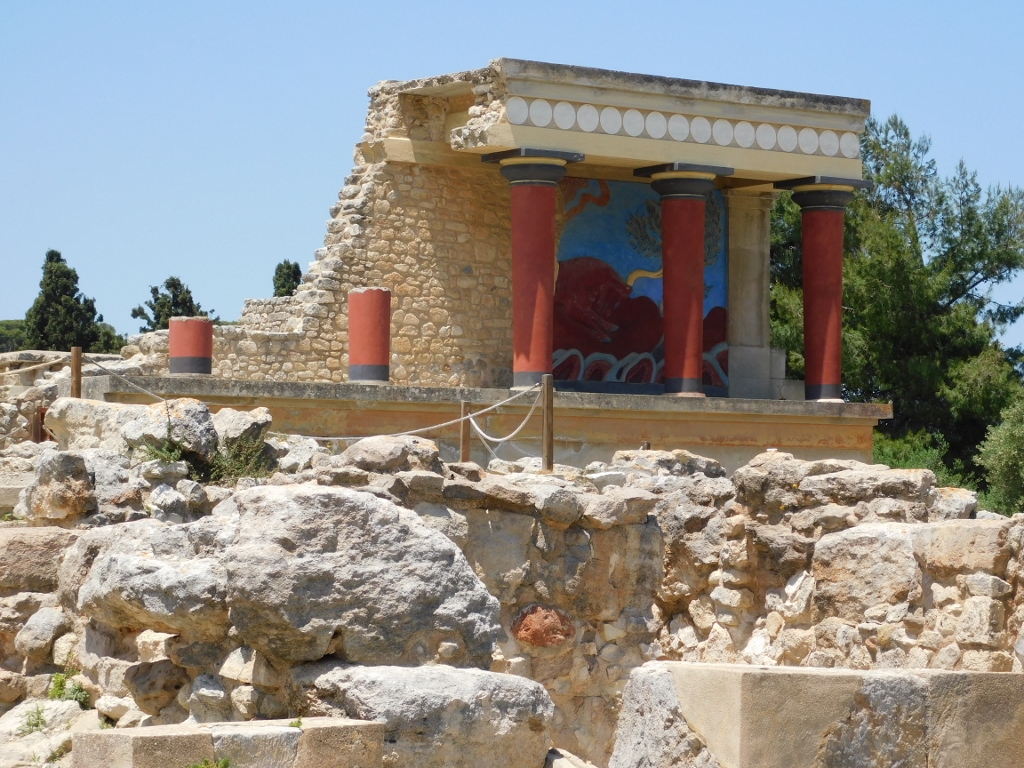 West Bastion
West Bastion
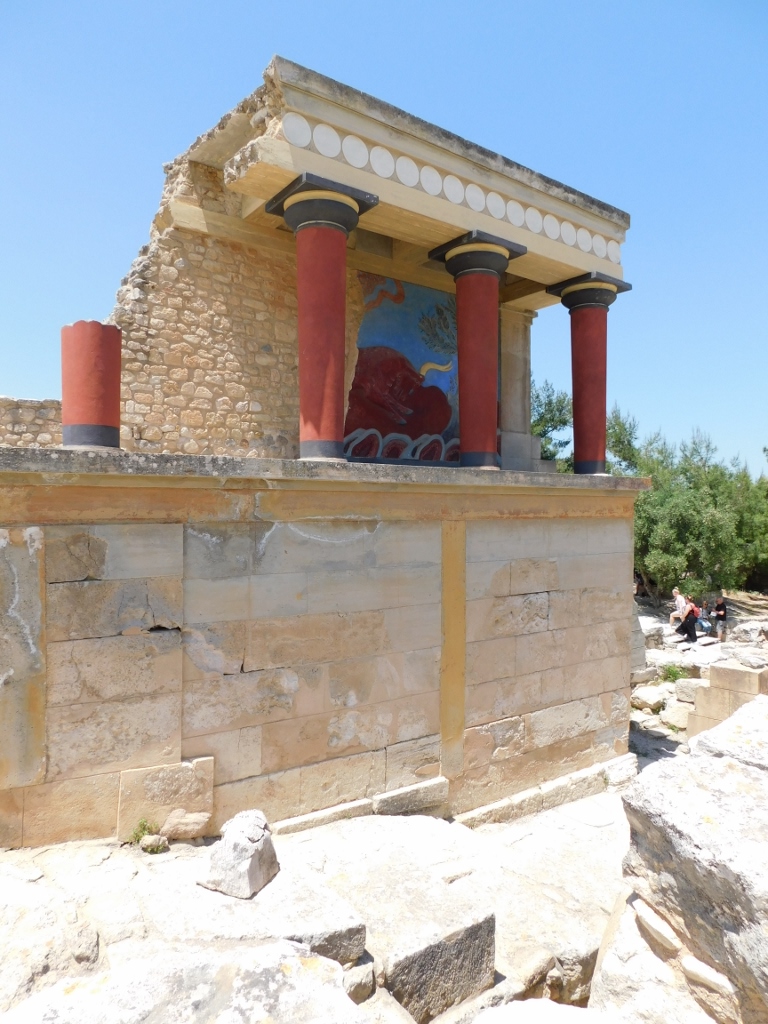 West Bastion
West Bastion
This structure has been partially reconstructed and raised above the surrounding ones since it is believed that a narrow hallway leading from the North Entrance into Knossos Palace to the Central Court passed underneath it.
Not only can one see both the picturesque pillars and architrave, but also there is an even more interesting relief fresco called “Charging Bull” from around 1500 BCE that decorates the wall behind the colonnade. A copy of a scene reconstructed on the basis of a small quantity of fragments and a lot of imagination was placed here already at the time of Evans’s excavations when the West Bastion was first reconstructed.
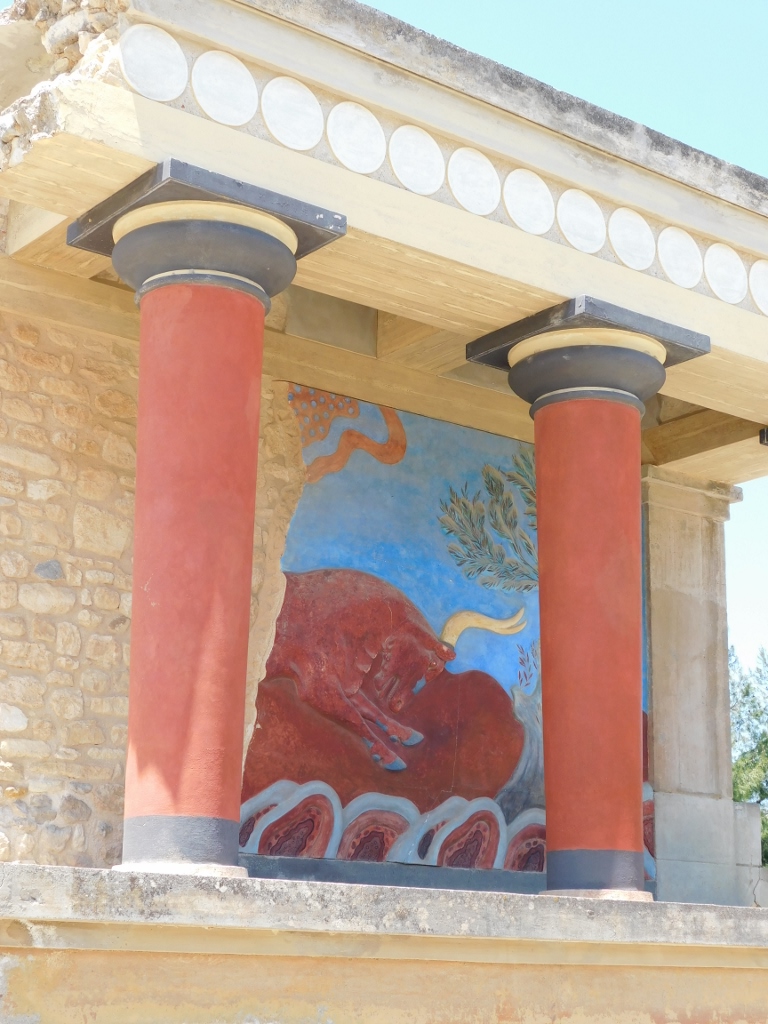 West Bastion, a detail
West Bastion, a detail
North of that narrow passage beside which the West Bastion was positioned it is possible to see remains of the North Pillar Hall.
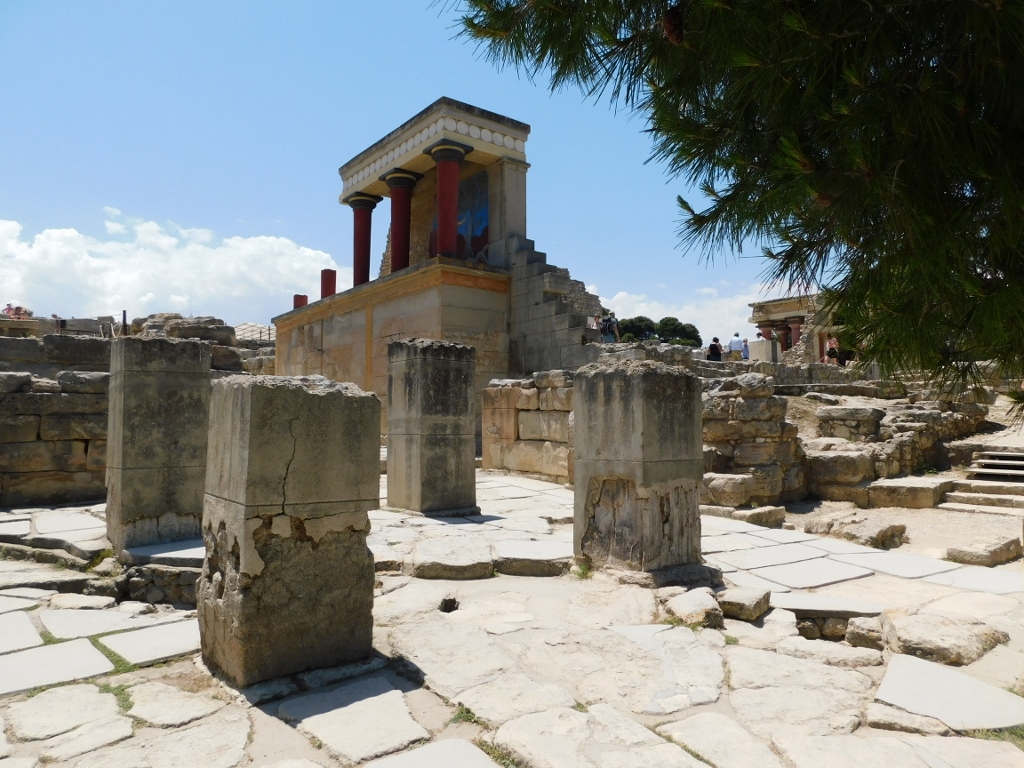 North Pillar Hall
North Pillar Hall
This used to be a large rectangular room (approx. 10 x 22 m) the roof of which was carried by two rows of pillars. There are several theories about what this space may have been used for and one of them was provided by Evans himself. Namely, this space is located on the north side of the Palace, which means that this is the seaward side. In this way, the products transported by the sea would first come here for inspection and therefore this area is sometimes called “Customs House.”
What I also noticed in this section of the Palace were water canals in the floor. It is quite clear that these canals were a part of a complex water management system that used to exist within the palace.
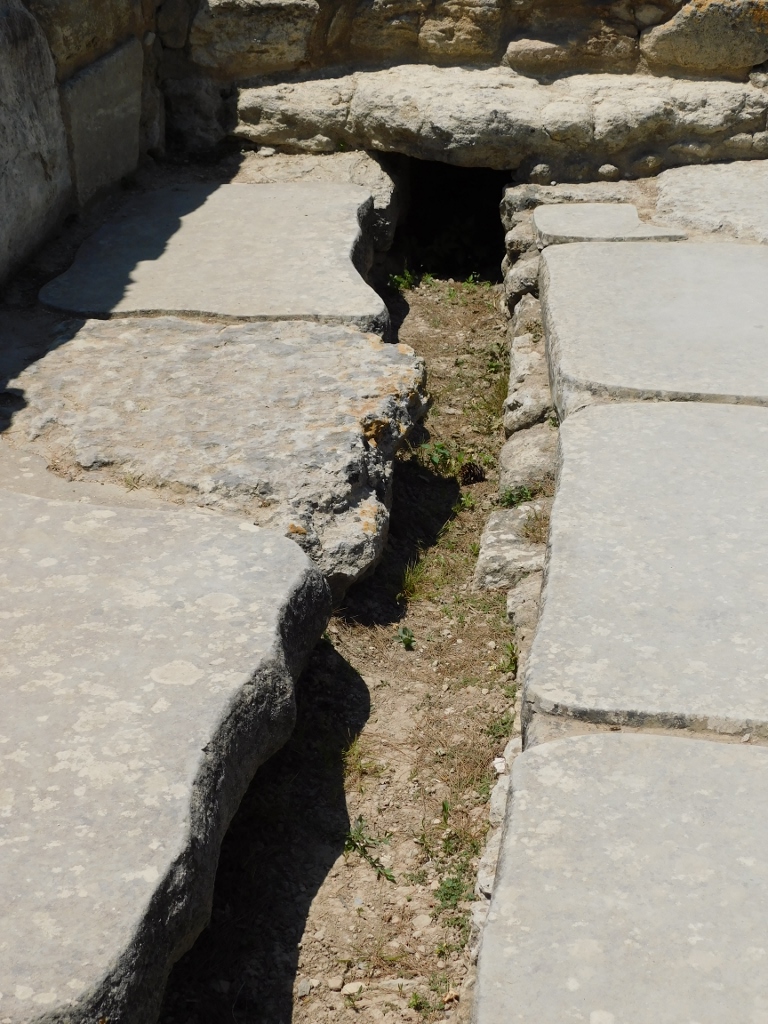 Part of the water management system at Knossos Palace
Part of the water management system at Knossos Palace
I walked a little more around the surroundings of the West Bastion climbing around the ruins here and there, where this was permitted, and then I went to yet another interesting place.
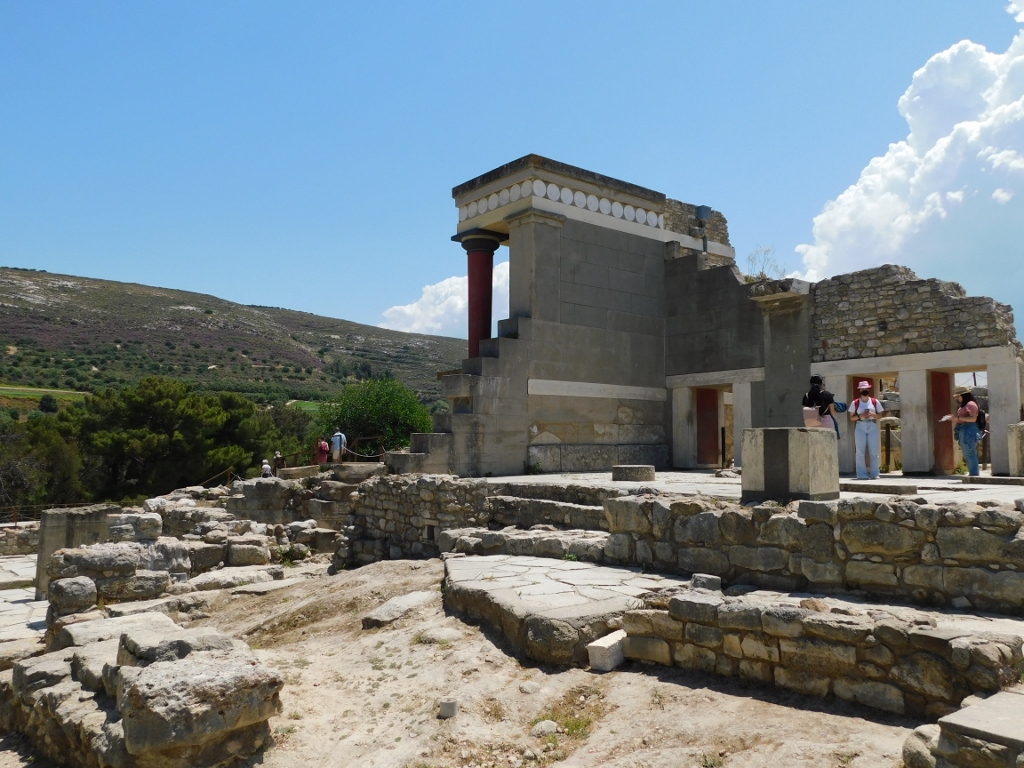 Knossos Palace, a detail
Knossos Palace, a detail
This part was named “Theatre” by Evans. The reason for this are the specifically positioned, at an angle, wide steps that seem to be intended for spectators who would be able to look at the paved plateau from there. Still, it was far too early for theatre at the time of the Minoan civilisation, so regardless of the name Evans believed that this was the venue where different ceremonies took place.
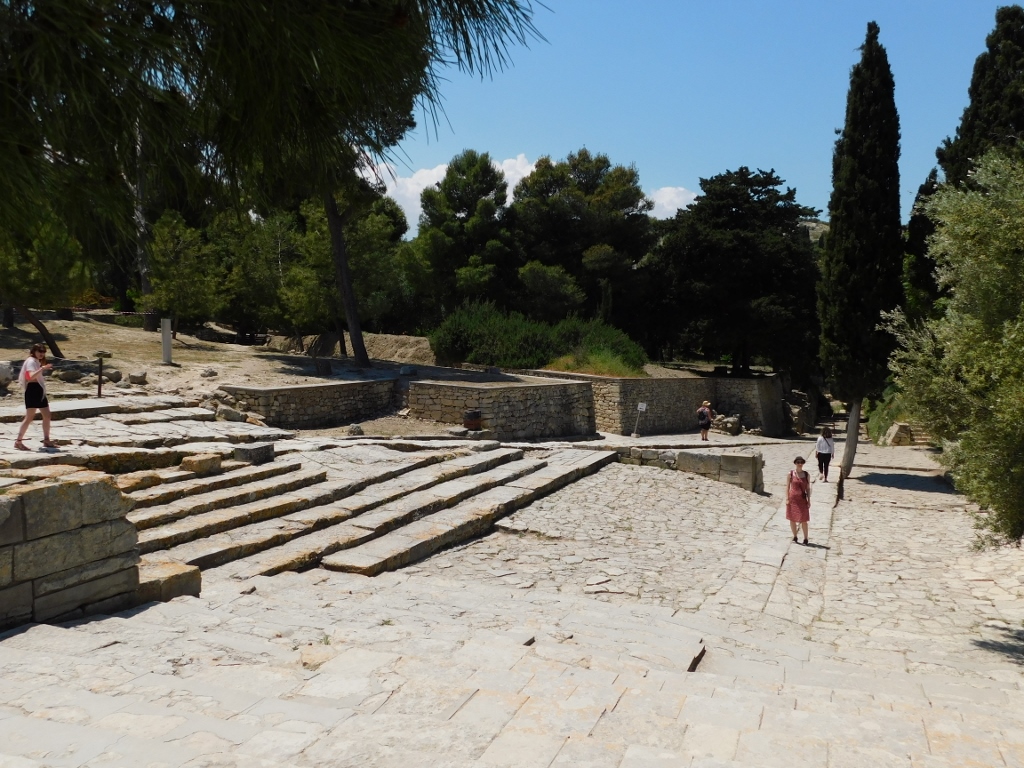 “Theatre”
“Theatre”
In the continuation of the paved plateau, there is a road which Evans named “Royal Road.” It may be used to go under the contemporary road leading from Heraklion and visit another segment of the site. I must admit I was no longer interested in looking at ruins. I played a little taking photos of a peacock that walked around this part of the site and there I completed my visit to Knossos Palace.
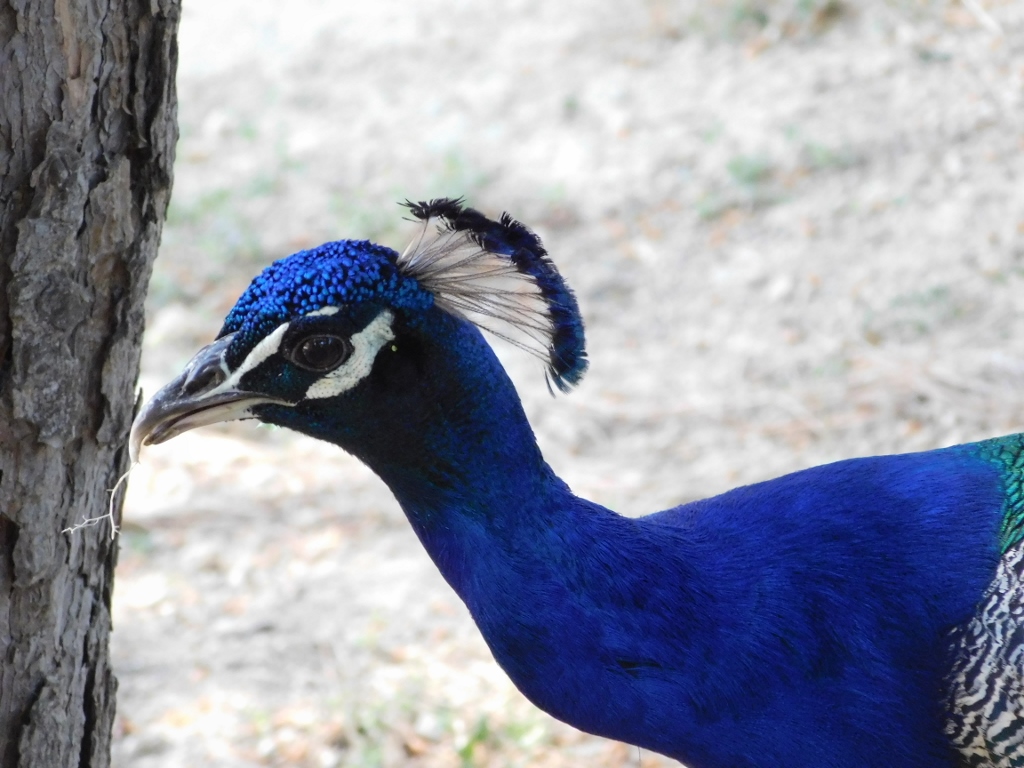 Knossos Palace, a detail
Knossos Palace, a detail
Before I definitely leave Knossos Palace with my story-telling, let me just mention that on the basis of the excavations and research it may be concluded that back in the day the palace was the centre of the political, economic and religious authority. Many of the different names of the sections of palace have been around since the time of Arthur Evans, the chief explorer of Knossos, who gave these names on the basis of his personal interpretation of the possible functions of these elements of the palace. On the other hand, more contemporary research suggests some other functions, but the names have mostly been kept.
Knossos Palace continued to be used even after 1450 BCE when the remaining palaces on Crete had already been ruined and because of the discovery of some documents written in a script used in Mycenae it is believed, as I have already mentioned, that the Palace was populated by the newcomers from the Greek mainland who also brought about the end of the Minoan civilisation.
As for me and my visit in May 2022, already while coming to Knossos and its palace by a bus, I concluded that 5 km, which is the distance between the archaeological site and Heraklion, was not too much and that I could easily cover that by walking.
And so, when I finished with the visit to the site, I simply started to return on foot. I knew that this would not be a particularly interesting stroll, but I do like to go on foot and the road here mostly descends mildly towards the north shore of Crete, so this was a very easy leisurely walk.
Still, before heading on, I had to take a photo of the sign with the name of the place. The signs here very kindly exhibit names written in Latin script as well, but it is not a bad thing for the visitor to get into the basics of the Greek alphabet. Although there is the expression “it’s all Greek to me,” this in fact is not that difficult.
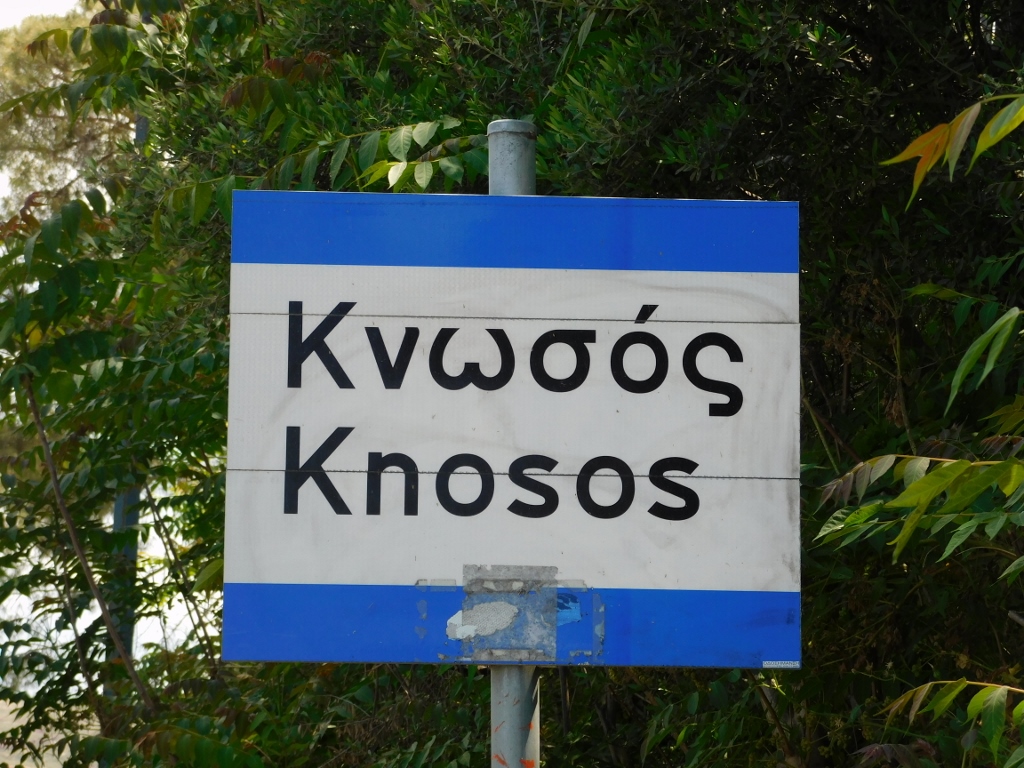 Knossos
Knossos
As I had presumed, the walk was boring, but at some point I got to a fish monger’s that also had a restaurant section. I did not feel particularly hungry, but I thought that it would not be a bad idea to eat something after all in order to avoid a possibility of being “late” for lunch. There are some parts of Europe in which restaurants are opened for lunch only during a fixed period of time and if one does not eat then, then there is simply nowhere else to eat (except for some fast-food joints or food from a supermarket). By the way, as much as I gathered later when I returned to Heraklion, this does not apply to Greece. The tourist office may not be open during weekends and the public transportation may not operate on Sundays, but restaurants and cafés work all the time. Or almost all the time.
Well, at this fish “restaurant” I’m mentioning, which is more like a very good fish monger’s, you go inside, show to an employee what you want to eat and then you take a seat. Whatever you have pointed at, be it fish, squid, shrimps, etc., they prepare (simply – grilled/baked or fried) and then bring to you. While I was sitting, waiting for my lunch, I could see that a lot of people came, ordered food and then left the restaurant with large bags full of boxes with the obviously packed up lunch they took home. The selection was fantastic, although I personally don’t think I made a very good choice. I obviously had a problem with food this day. All of my choices seemed wrong. It was all edible and certainly not bad, but – not inspiring enough. I thought it would take a little time for Crete and I to get used to each other.
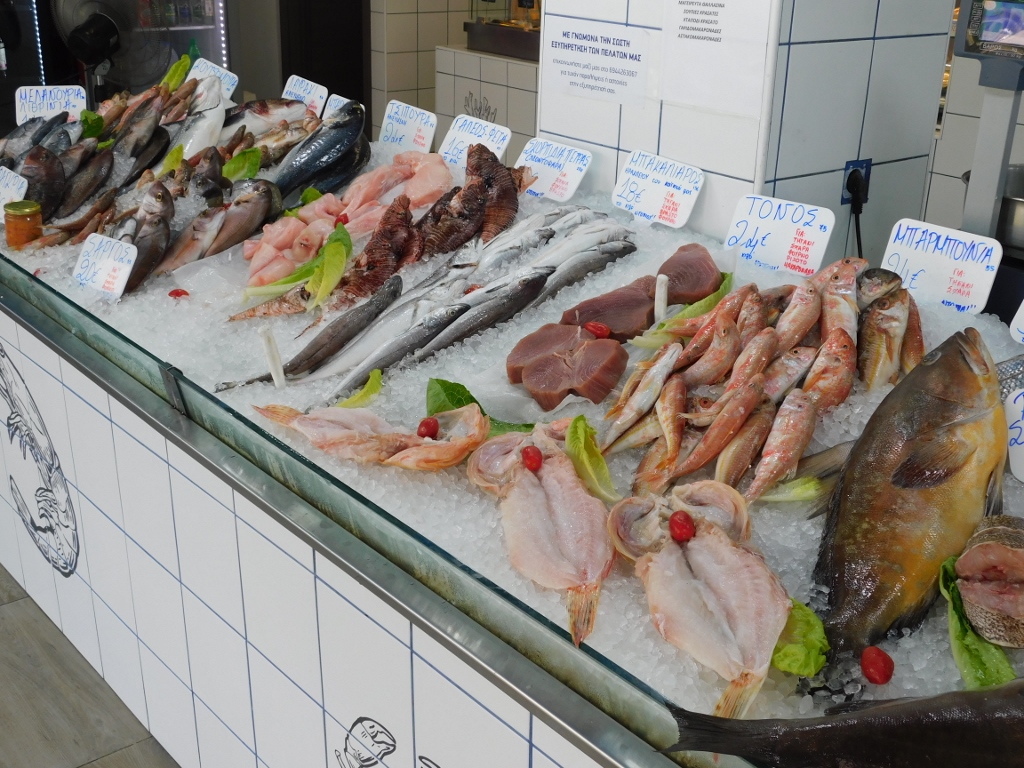 Part of the offer at the fish monger’s/restaurant
Part of the offer at the fish monger’s/restaurant
After a while I reached the outskirts of the old town in Heraklion. This is easy to recognise since the centre of Heraklion is surrounded by 5 km long Venetian Walls built in the 16th and the 17th centuries.
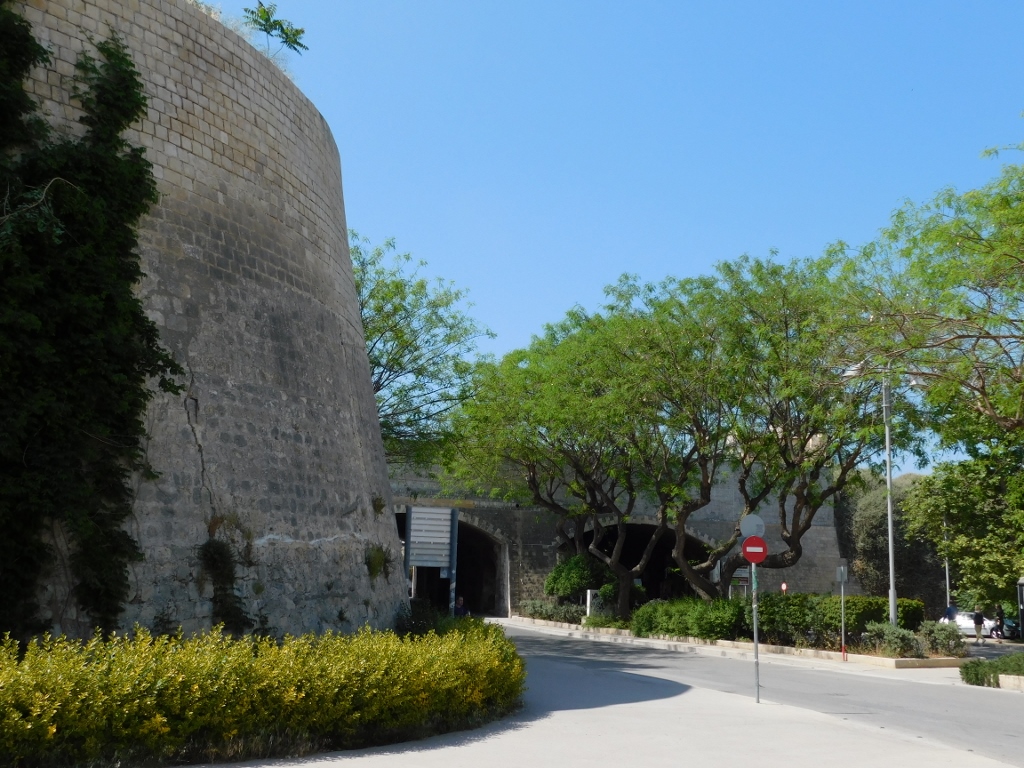 Venetian Walls that surround the central area of Heraklion
Venetian Walls that surround the central area of Heraklion
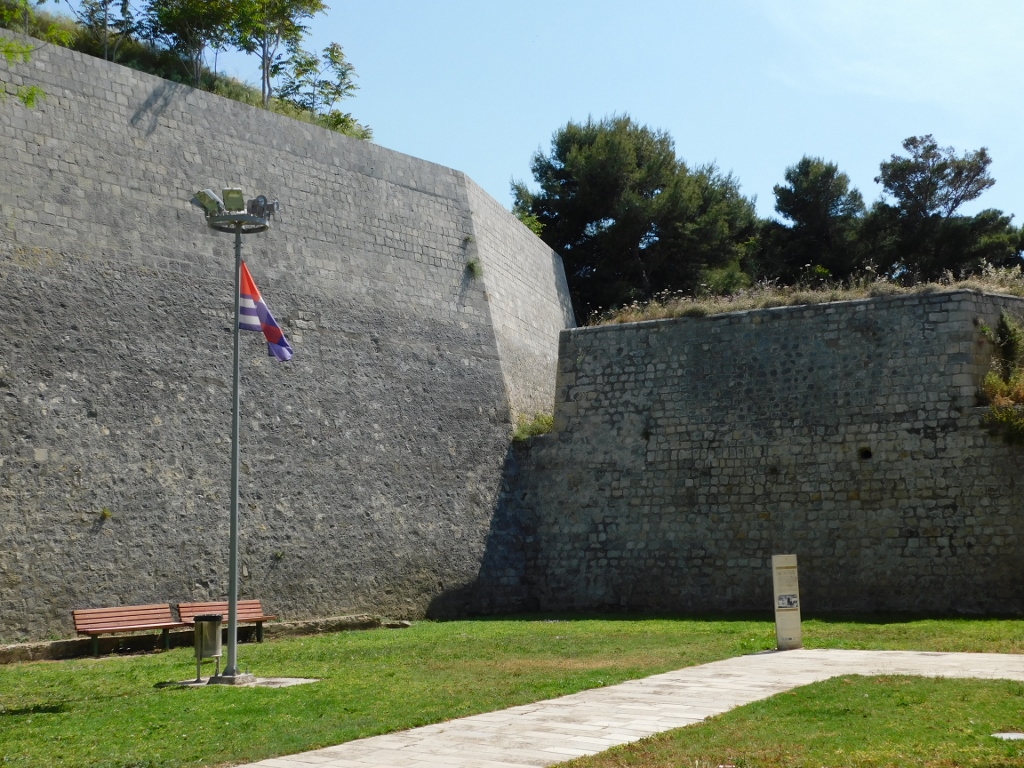 Venetian Walls, a detail
Venetian Walls, a detail
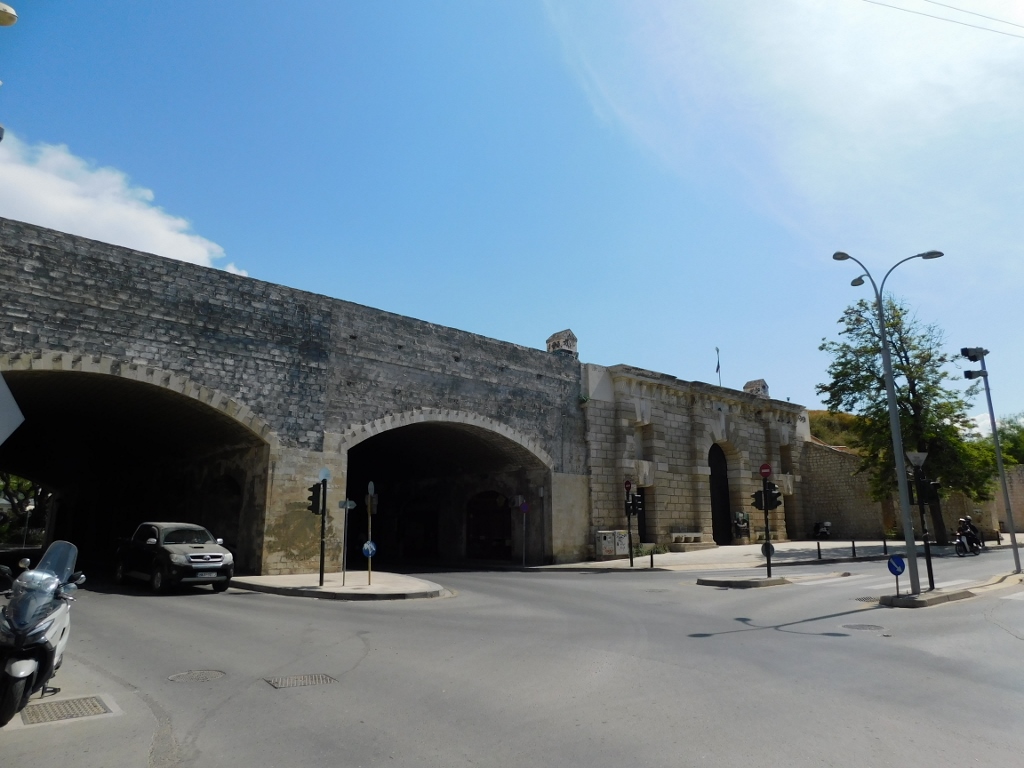 Venetian Walls: the New Gate (Kenourgia Porta) on the right is from 1587
Venetian Walls: the New Gate (Kenourgia Porta) on the right is from 1587
The Venetians took Crete over after the Byzantines and Arabs in the 13th century, but they were exceptionally unpopular (to put it mildly) among the local population on account of the very high taxes. Still, this did not bother the Venetians who turned Heraklion (at the time known under the name of Candia) into a very important commercial and military centre in the east part of the Mediterranean. In line with that, they fortified the town and built numerous churches, private and public buildings, some of which have survived to the present times.
However, in 1648, the Ottomans got to Crete and started with the Grand Siege of Candia that lasted until 1669 when after the large number of victims on both sides the Venetians finally withdrew, while Crete fell under the Ottoman rule. Over time, Candia lost its primary position and the capital of the island moved to Chania. It was only in 1971 that the capital moved back to Heraklion.
By the way, according to the legend, Heraklion owes its name to Herakles, the ancient Greek hero, who back in the day came to Crete in order to fulfil one of his Twelve Labours and that was to overpower Cretan Bull. This was the same bull who fathered Minotaur, which I have written about before. Be as it may, bare-handed Herakles successfully completed his task, although the bull even spit fire and the battle took its time, but in the end Herakles even took the defeated Cretan Bull on his shoulders to the area close to Mycenae in Peloponnese.
In the period between the Minoan and Mycenaean rule over Crete and between the periods when the Venetians and Ottomans were here, Crete was ruled by the Greeks from the mainland, as well as the ancient Romans, Byzantines and Arabs. All of them have left trace on the island in one form or another. And so, when you get to a small square at the south end of a well-known 1866 street, you can see an Ottoman public fountain called the Ottoman Pumphouse from 1776.
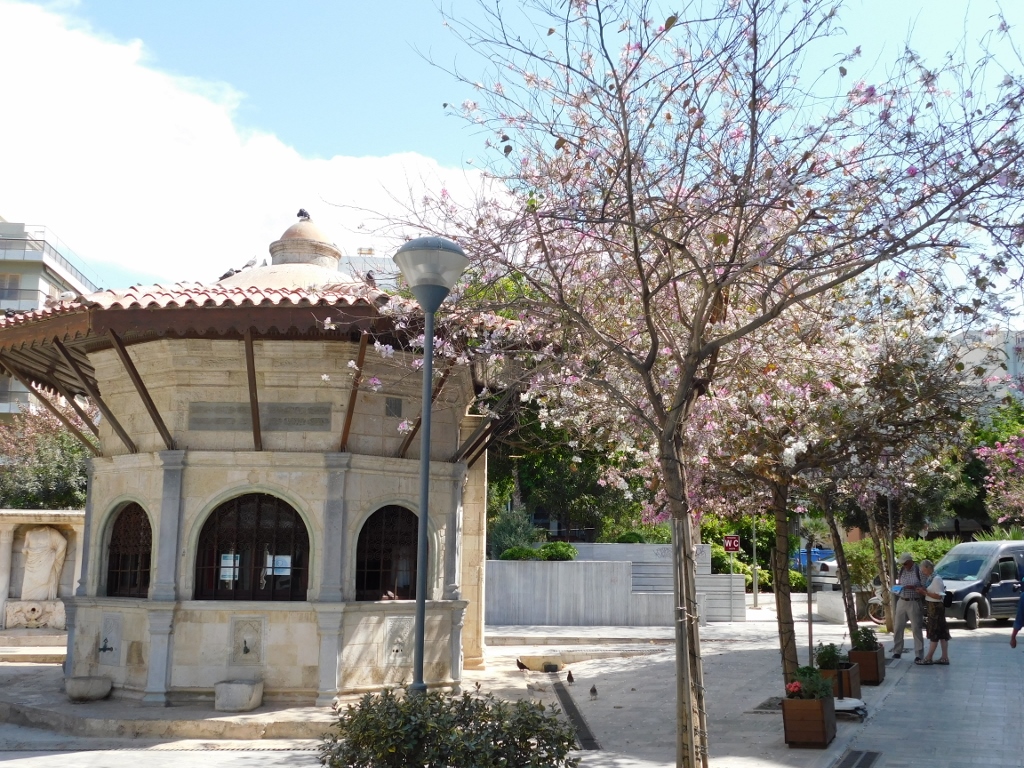 Public fountain from the Ottoman period
Public fountain from the Ottoman period
Right behind this fountain seen in the photo above, to the left, you can see a part of a fountain from the Venetian period called the Bembo fountain which was built in the 16th century.
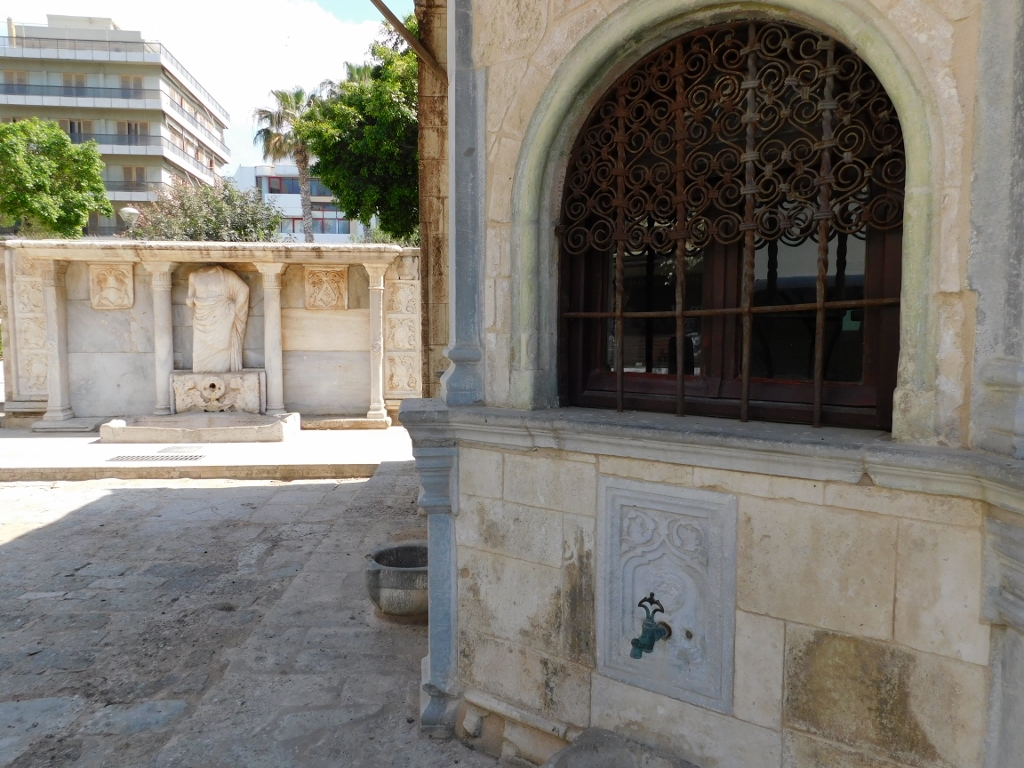 Two fountains from different periods
Two fountains from different periods
From this square in the northbound direction starts the street of an unusual name, “1866,” which comes from the year when a very important uprising against the Ottoman rule took place. Different materials mention that the main market in the city is located in this street, but although it is possible to find shops and stands with food and fish in the side streets, this particular street has shops that mainly offer goods for tourists: souvenirs, cheap footwear and clothes, then souvenirs again and yet a little more souvenirs. So, if you are not interested in souvenirs, suffice to walk here just once, only to see the street.
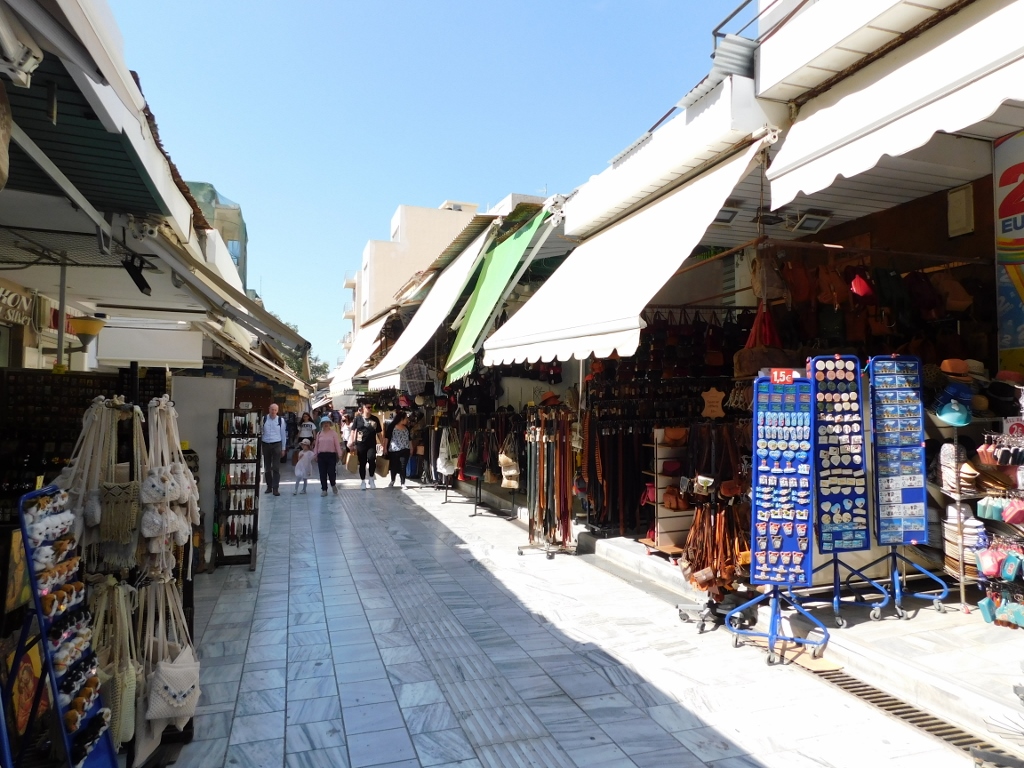 1866 Street
1866 Street
When you get to the end of the street it is necessary to walk a few dozen metres more and then you get to the Lions Square and the fountain of the same name. I have already talked about the fountain and the official names in the first sequel of my Crete travel stories. Now, here are a couple of more photographs as a reminder of this pretty fountain from the Venetian rule period.
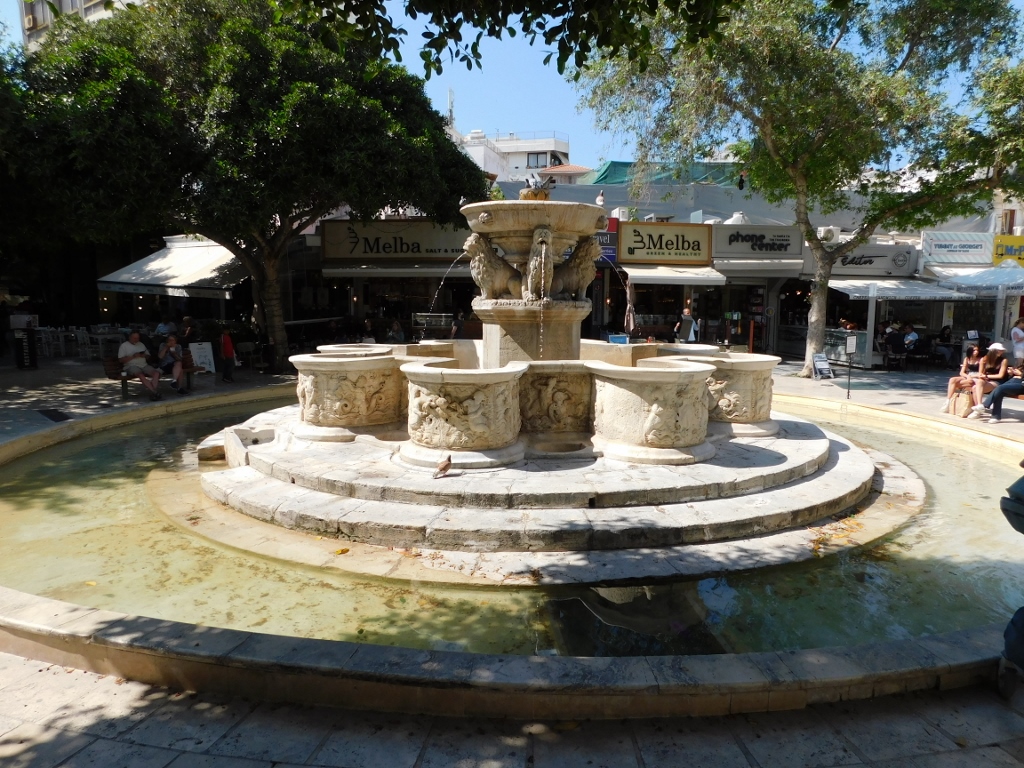 Lion’s Fountain
Lion’s Fountain
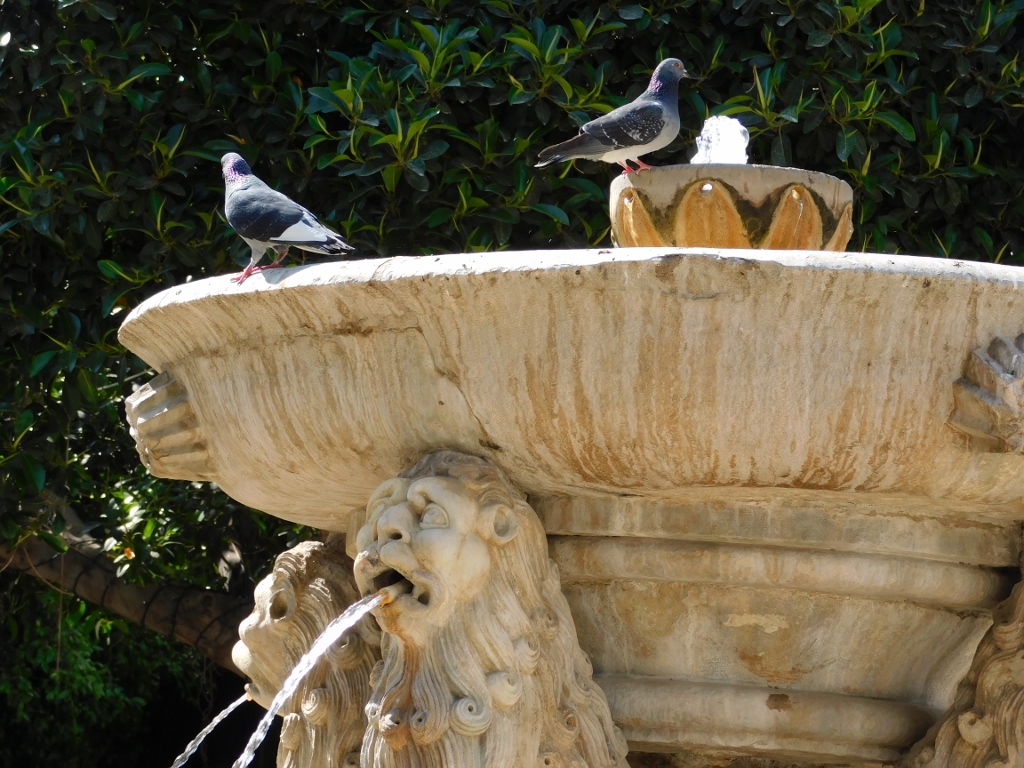 Lion’s Fountain, a detail
Lion’s Fountain, a detail
At one of the ends of the Lion’s Square and in its direct surroundings, there are a few more interesting buildings. One of them is the Basilica of St. Mark built here by the Venetians in 1239. However, after the Ottoman conquest, the church was turned into a mosque in 1669 and was used as such until 1915. It was restored in 1956 and since then it has been used as an art gallery. On this occasion it was closed, but later, during my stay, I managed to visit its interior as well.
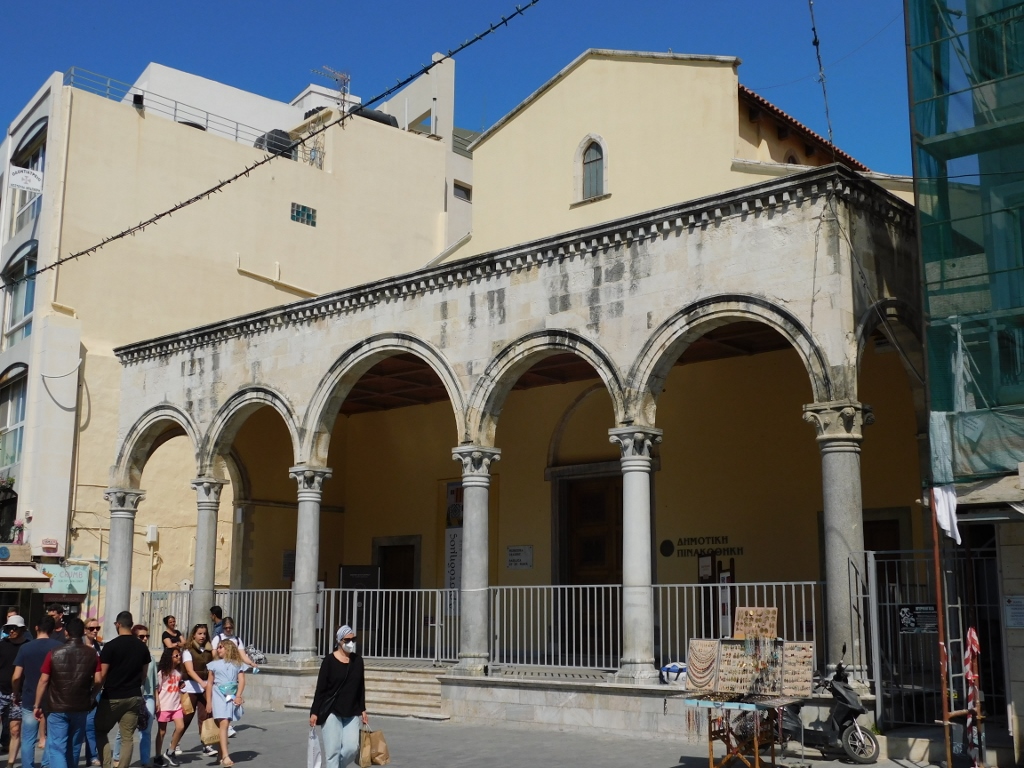 Basilica of St. Mark
Basilica of St. Mark
Several dozen metres farther, there is the Venetian Loggia. The original edifice at this site was built around the middle of the 16th century, but it got the shape that can be seen today in the first half of the 17th century. It is believed to be one of the most beautiful Venetian monuments in Crete. This was the place where merchants, as well as noblemen gathered and it constituted the centre of the economic and social life in Candia, which was, let me remind you, the name used by the Venetians for the present-day Heraklion.
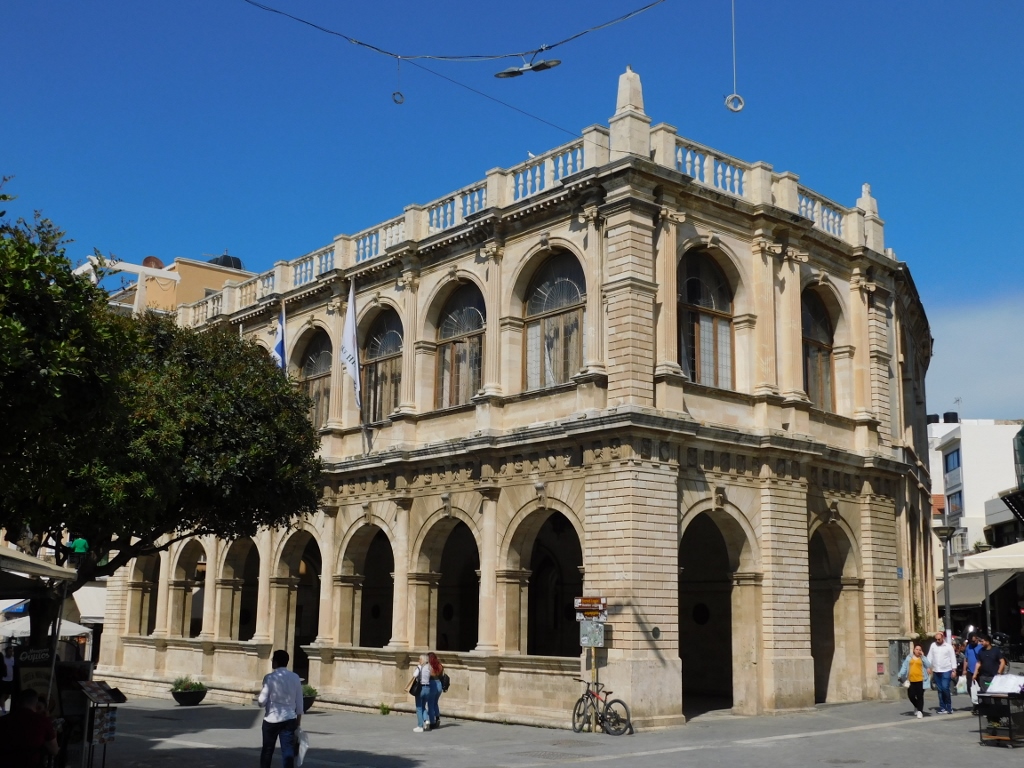 Venetian Loggia
Venetian Loggia
Needless to say, the Ottomans used the building after the conquest, but as the place for the public treasury. After the liberation the restoration of the building started, but it took a while. Eventually, the loggia was quite successfully and nicely restored and today it serves as the Town Hall.
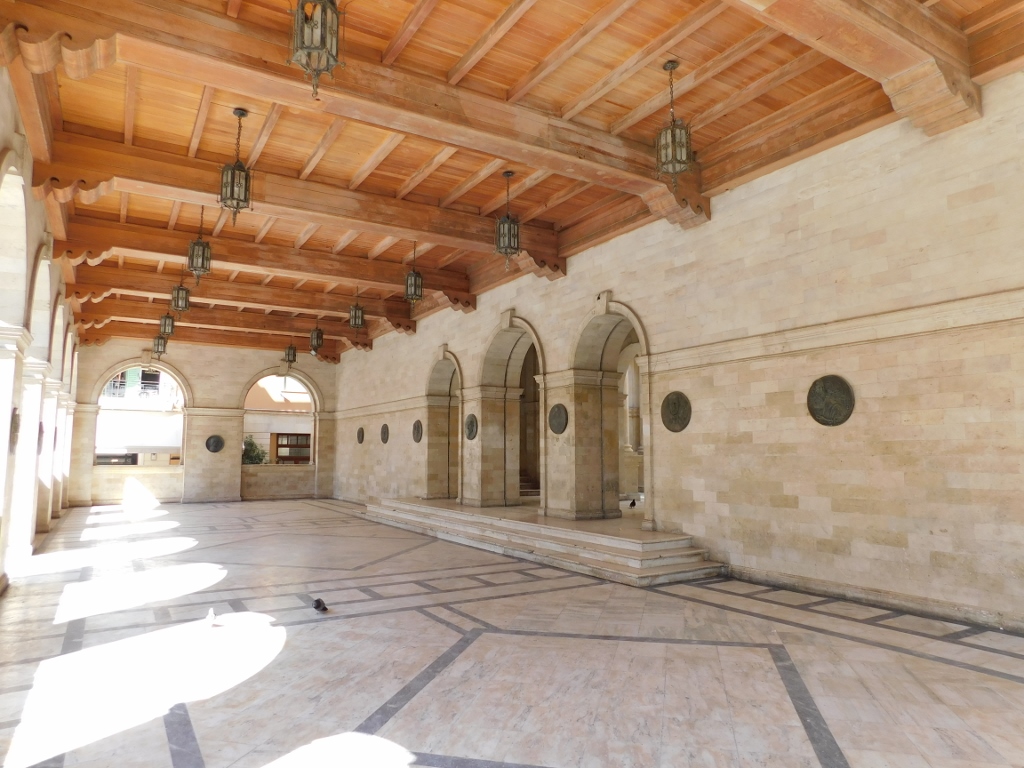 Venetian Loggia: the spacious portico
Venetian Loggia: the spacious portico
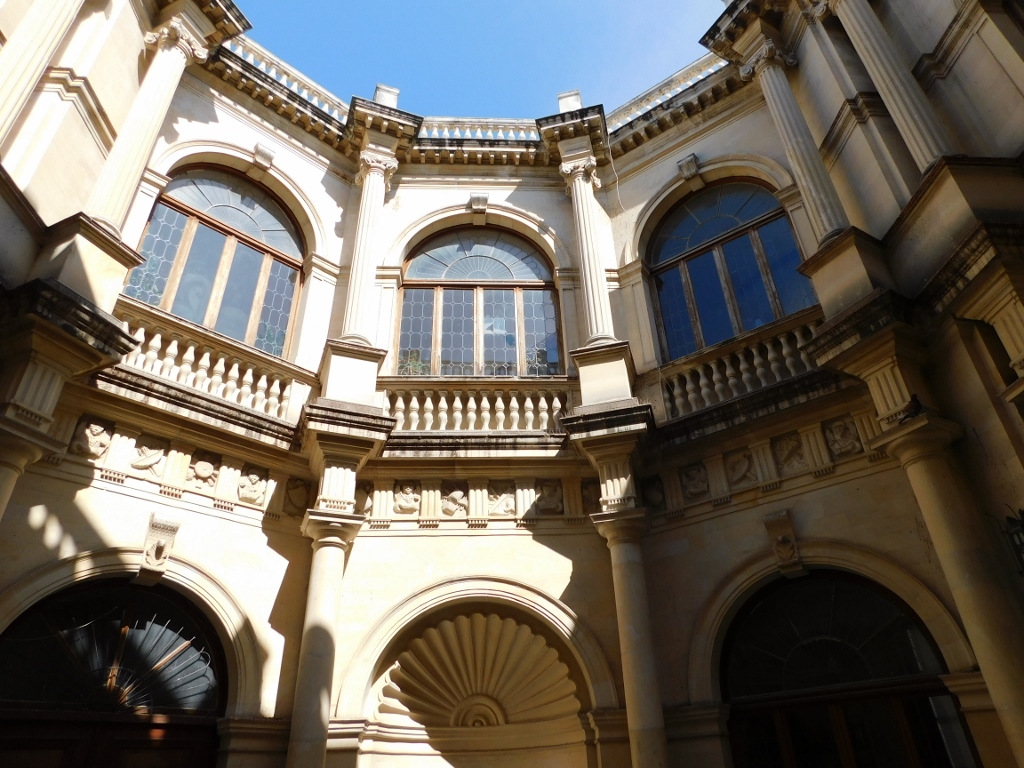 Venetian Loggia: the inner courtyard
Venetian Loggia: the inner courtyard
By this time, I was a little tired with all the sightseeing and walking, so I took advantage of the fact that the flat I had rented was nearby, so I went there in order to have some rest.